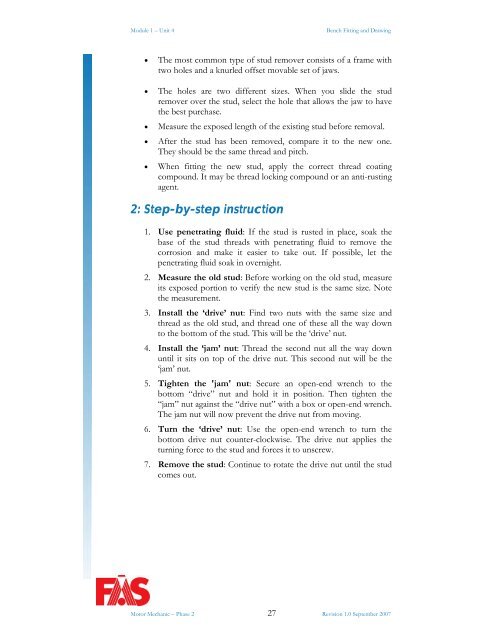TRADE OF HEAVY VEHICLE MECHANIC - eCollege
TRADE OF HEAVY VEHICLE MECHANIC - eCollege
TRADE OF HEAVY VEHICLE MECHANIC - eCollege
You also want an ePaper? Increase the reach of your titles
YUMPU automatically turns print PDFs into web optimized ePapers that Google loves.
Module 1 – Unit 4 Bench Fitting and Drawing<br />
• The most common type of stud remover consists of a frame with<br />
two holes and a knurled offset movable set of jaws.<br />
• The holes are two different sizes. When you slide the stud<br />
remover over the stud, select the hole that allows the jaw to have<br />
the best purchase.<br />
• Measure the exposed length of the existing stud before removal.<br />
• After the stud has been removed, compare it to the new one.<br />
They should be the same thread and pitch.<br />
• When fitting the new stud, apply the correct thread coating<br />
compound. It may be thread locking compound or an anti-rusting<br />
agent.<br />
2: Step-by-step instruction<br />
1. Use penetrating fluid: If the stud is rusted in place, soak the<br />
base of the stud threads with penetrating fluid to remove the<br />
corrosion and make it easier to take out. If possible, let the<br />
penetrating fluid soak in overnight.<br />
2. Measure the old stud: Before working on the old stud, measure<br />
its exposed portion to verify the new stud is the same size. Note<br />
the measurement.<br />
3. Install the ‘drive’ nut: Find two nuts with the same size and<br />
thread as the old stud, and thread one of these all the way down<br />
to the bottom of the stud. This will be the ‘drive’ nut.<br />
4. Install the ‘jam’ nut: Thread the second nut all the way down<br />
until it sits on top of the drive nut. This second nut will be the<br />
‘jam’ nut.<br />
5. Tighten the 'jam' nut: Secure an open-end wrench to the<br />
bottom “drive” nut and hold it in position. Then tighten the<br />
“jam” nut against the “drive nut” with a box or open-end wrench.<br />
The jam nut will now prevent the drive nut from moving.<br />
6. Turn the ‘drive’ nut: Use the open-end wrench to turn the<br />
bottom drive nut counter-clockwise. The drive nut applies the<br />
turning force to the stud and forces it to unscrew.<br />
7. Remove the stud: Continue to rotate the drive nut until the stud<br />
comes out.<br />
Motor Mechanic – Phase 2 27 Revision 1.0 September 2007
















